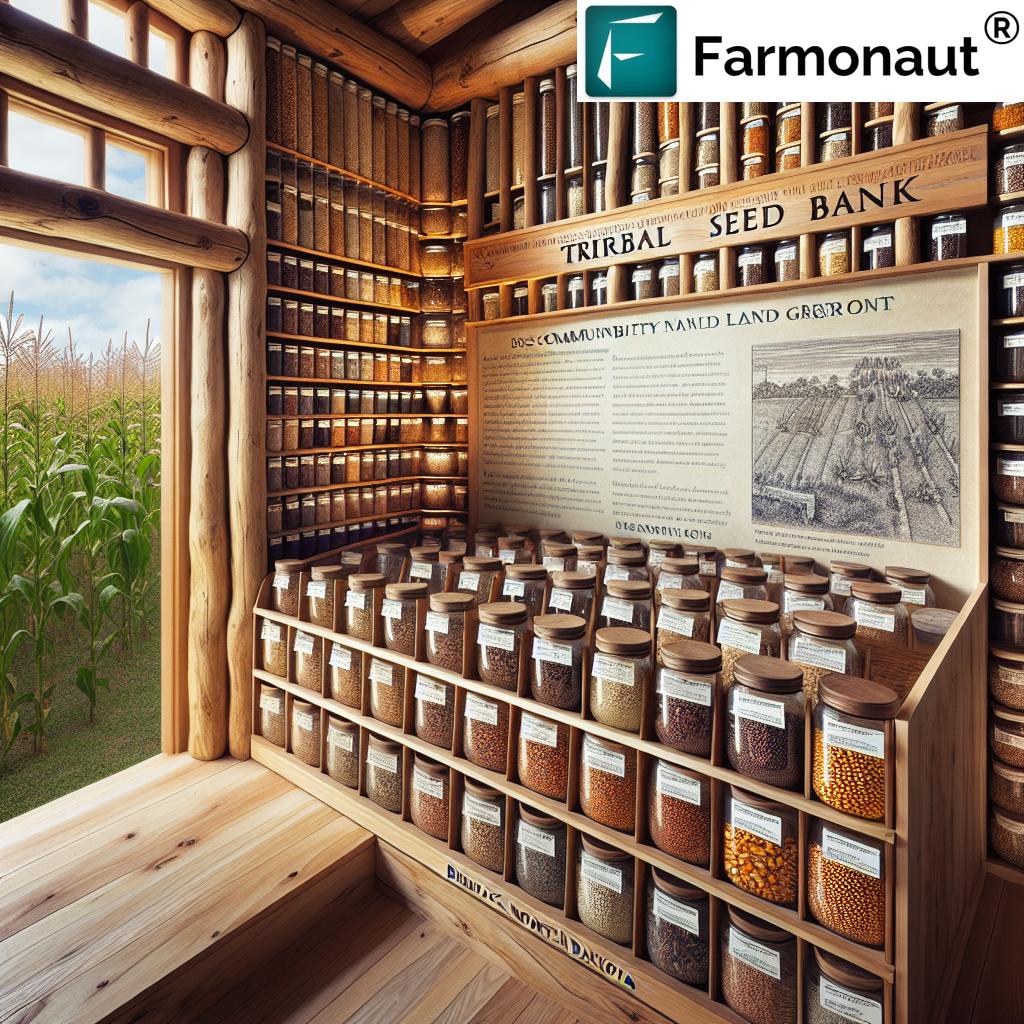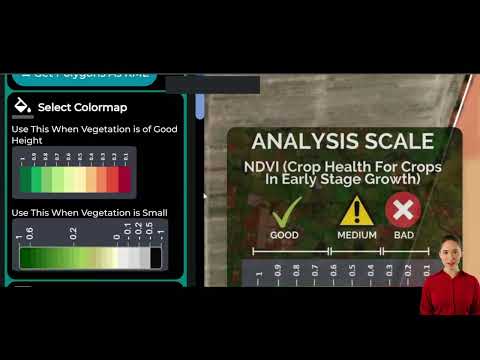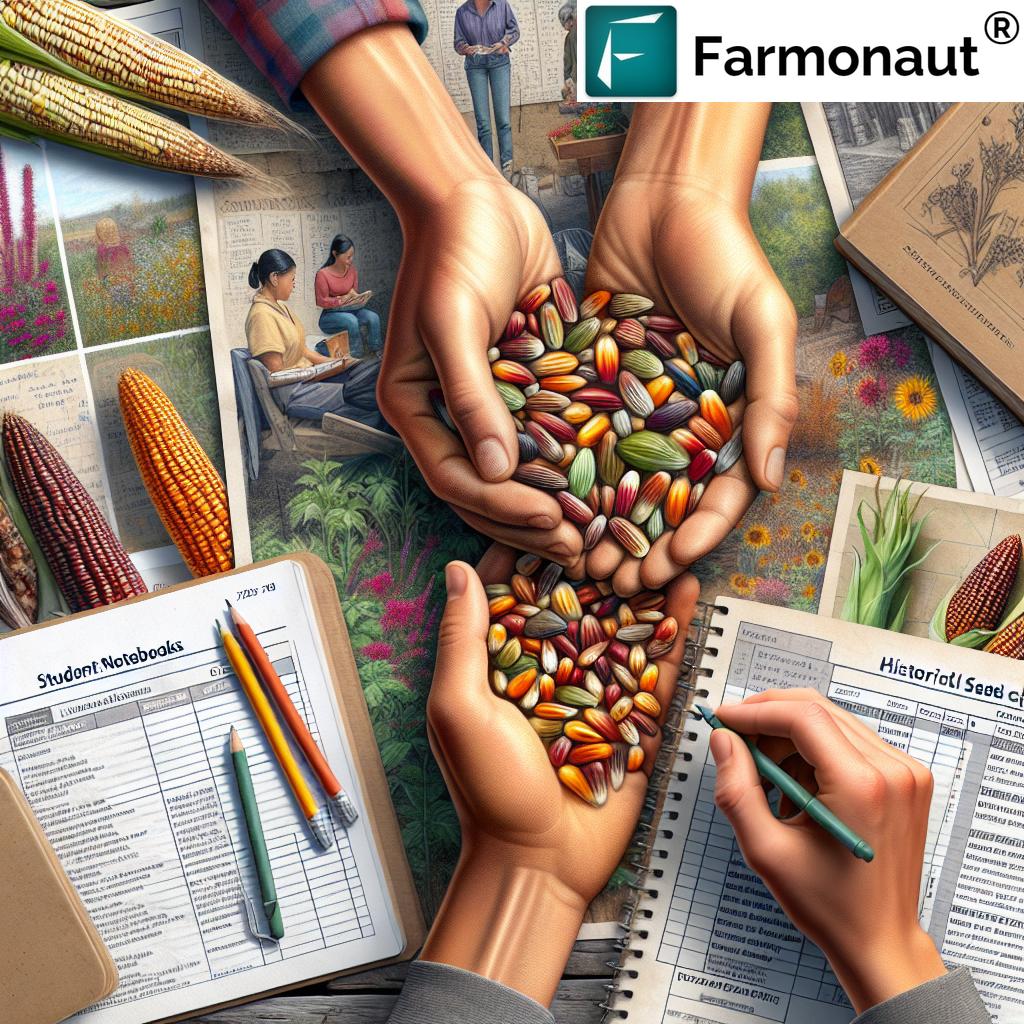5 Effective Native Seed Preservation Methods in Bismarck Communities
“Over 70% of Bismarck’s native seeds are preserved through tribal seed banks, ensuring crop diversity for future generations.”
Introduction: The Power of Native Seed Preservation
In the heart of North Dakota, Bismarck communities are reinvigorating the legacy of native seed preservation. In a world where agricultural practices change rapidly—and where global food security faces increasing challenges—our commitment to safeguarding indigenous seeds, particularly heirloom corn seeds and other heritage crops, is vital. We preserve not only living genetic material but the ancestral knowledge, cultural heritage, and sustainable agriculture methods that have carried Native communities for countless generations.
Through collective action, modern science, and traditional wisdom, projects like the United Tribes Technical College (UTTC) Land Grant initiative are transforming how we view seed banks, sustainable food systems, and our shared future. Join us as we explore five effective native seed preservation methods in Bismarck communities, discover their cultural and practical importance, and see how these practices open new pathways for our families, students, and future generations.
Why Preserve Native Seeds?
Native seed preservation is a foundation for food sovereignty, biodiversity, and climate resilience in our communities. It ensures we maintain access to the crops our ancestors nurtured for centuries—crops adapted perfectly to our land and climate, resistant to local pests and weather, and rich in the nutrients our bodies need. By preserving native seeds, we:
- Protect historical genetic diversity: Each heirloom seed carries unique traits honed by generations of careful selection and traditional stewardship.
- Maintain cultural heritage: Sacred corn, beans, squash, and other crops are embedded in our ceremonies, stories, and daily life.
- Support food security and sovereignty: Control over our food systems enables self-determination, supports economic independence, and empowers future generations.
- Promote sustainable and regenerative agriculture: Traditional agriculture practices are inherently sustainable and resilient, drawing from an intimate understanding of our local environment.
Projects like those at the United Tribes Technical College focus on long-term seed viability, historical seed cataloguing, and community-driven propagation. By combining sustainable agriculture programs with indigenous knowledge, we sow the seeds for a thriving and resilient future.
“Five preservation methods in Bismarck communities safeguard seeds vital to both sustainable agriculture and cultural heritage.”
Bismarck Tribal Seed Banks: Guardians of Heritage
At the center of our preservation efforts lies the creation and stewardship of tribal seed banks. These community-driven initiatives are now thriving at the United Tribes Technical College campus in Bismarck, thanks to the dedication of students, educators, and agricultural leaders. By focusing on seed propagation systems, crop cataloguing, and collaborative stewardship, tribal seed banks have become the heartbeat of our sustainable agriculture initiatives.
- Land Grant Agriculture Initiatives: Supported by educational institutions such as UTTC through the Agro Admin App for Large-Scale Farm Management, land grant programs facilitate the transfer of both knowledge and physical seeds to community members, tribal colleges, and neighboring reservations.
- Community Crop Sharing: We share not just food, but the means for families and communities to grow their own — strengthening our ties to this land and to each other.
- Historical Seed Cataloguing: Through systematic records and databases, we honor the history and characteristics of every variety, from the most ancient to the recently reintroduced.
Did you know? Some of the seeds in these banks, such as varieties of corn, have been grown for over 150 years and are now returning home to Bismarck communities from distant preservation locations. We believe keeping these seeds alive is a living act of sovereignty, resilience, and hope.
Comparative Table: 5 Native Seed Preservation Methods
| Method Name | Key Steps | Estimated Preservation Duration (Years) | Community Involvement Level | Cultural Significance |
|---|---|---|---|---|
| Traditional Dry Storage | Air-drying seeds, storing in baskets or clay pots, keeping in cool, dry, dark places | 2–10 | High | Ancestral practice; protects genetic lineage and links community to ancestral cultivation methods |
| Community Seed Saving & Crop Sharing | Selective harvesting, communal seed exchanges, distributed seed keeping | 5–50 | Very High | Fosters collective stewardship; builds intergenerational knowledge networks |
| Seed Banks & Cataloguing at UTTC | Controlled storage, detailed documentation, digital and physical inventories | 10–100+ | High | Ensures intertribal access; symbolic of sovereignty; institutionalizes preservation for future generations |
| In-Ground Living Preservation | Annual/biannual planting and harvest cycles, participatory propagation, field adaptation | Continuous | Very High | Preserves seeds through life; links growing, harvesting, and ceremony |
| Controlled Environment Storage (Cold Storage) | Refrigeration or freezing, vacuum sealing, regulated humidity & temperature | 20–100+ | Medium | Adds modern science to tradition; crucial for rare & legacy seed varieties |
1. Traditional Dry Storage: Honoring Ancestral Wisdom
The most time-tested native seed preservation method is traditional dry storage. Our elders have long understood that the life force of seeds is best preserved when protected from moisture, heat, and pests. In this method, seeds—such as heirloom corn seeds—are carefully dried, typically in open air under shade. Once dried, they are stored in containers crafted from natural materials like woven baskets, clay pots, or even animal hides.
Key Steps:
- Air-drying seeds after harvest, ensuring all moisture has evaporated
- Protecting from direct sunlight to prevent damage
- Storing in breathable containers to allow airflow yet shield from pests
- Placing containers in cool, dark, dry spaces (often underground cellars or in the rafters of traditional dwellings)
Benefits & Challenges:
- Accessible & affordable: Utilizes local resources, requiring no costly equipment
- Community-driven: Involves families and generations in both practice and teaching
- Duration: Seeds typically remain viable for 2–10 years, depending on crop variety and storage conditions
- Risk: Susceptible to moisture, rodents, and temperature extremes if not carefully maintained
Preserving native crops this way shapes our collective memory, reinforcing our cultural bonds and passing heritage to our youngest members. It also keeps us grounded in the knowledge of the land—knowledge we can never afford to lose.
2. Community Seed Saving & Crop Sharing: Collective Guardianship
The fabric of our native communities is strengthened by community seed saving and crop sharing. Here, the seed bank is not confined to a single institution but is shared, grown, regenerated, and distributed by many households—across reservations, tribal colleges, and among neighbors.
How It Works:
- After harvest, only the healthiest, most resilient seeds are set aside for the next season
- Families and groups host exchanges where seeds are traded, gifted, or entrusted for safekeeping
- Knowledge about cultivation, selection, and seed longevity is shared along with the seeds themselves
- Crops are planted in diverse plots and microclimates to test and maintain genetic adaptability
Core Outcomes:
- Genetic resilience: Seeds adapt to a changing environment through cross-pollination and selective breeding
- Intergenerational ties: Elders, youth, and students learn from one another during collaborative seed saving efforts
- Sustainability: Reduces reliance on external seed supplies or commercial hybrids
This method is truly at the heart of the Bismarck tribal seed banks model, ensuring living seeds—and the knowledge to grow them—flow freely within our families and throughout our land.
3. Seed Banks & Cataloguing at UTTC: Building for the Future
Through the Land Grant program at United Tribes Technical College, Bismarck communities have established a formal seed bank backed by scientific expertise and robust management. Here, historical seed cataloguing safeguards each variety’s provenance, characteristics, and usage history. Both digital and physical systems are used to track inventory, facilitate community- and inter-college access, and ensure that seeds are never lost to time.
Key Aspects:
- Controlled Environment: Seeds are stored in climate-monitored rooms or storage boxes, limiting exposure to contaminants and pests.
- Seed Propagation Systems: Regular germination testing and replenishment cycles keep seed stocks alive and viable.
- Digital Inventory: Software records track seed source, genetic information, storage date, and community usage, ensuring transparency and traceability.
- Outreach & Sharing: Seeds are shared with tribal colleges, local reservations, and families to encourage distributed preservation and strengthen sovereignty.
With the advent of technology, community members can access details about their seeds, plot planning, or even share data across distances for collaborative research. The Bismarck model supports sustainable agriculture programs not just through preservation but by ensuring broad, equitable access to our agricultural inheritance.
Did you know? Farmonaut’s Product Traceability Platform brings blockchain-backed transparency, allowing native seed banks to track every step from cataloguing to distribution. This raises trust, ensures accurate records, and supports regulatory needs for both campus and broader tribal community efforts.
4. In-Ground Living Preservation: Letting Seeds Live
Some seeds are best preserved as living organisms, propagated season after season in the soil they call home. In-ground preservation ensures that seeds remain adapted to environmental changes, pests, and evolving climate conditions. This continuous cycle mirrors traditional agriculture practices and is a living archive of both genetic and cultural heritage.
How It Works:
- Crops are planted annually in managed plots, gardens, and fields on campus, in reservations, and at home gardens
- Plants are observed for health and resilience; the best specimens are allowed to mature and seed for next year
- Communities, especially youth and students, learn by direct participation in planting, caretaking, and harvesting
- Seeds are distributed each season, regenerating stocks through shared harvests
This seed propagation system not only combats genetic erosion but actively celebrates our cultural practices—feasts, ceremonies, and teaching moments weave seed stewardship into daily life.
- Infinite duration, as long as planting continues
- Directly links preservation with ceremony, food sovereignty, and traditional knowledge transmission
Benefit: By integrating this method, we engage communities in hands-on learning, reinforce resilience, and nurture the next generation of native crop stewards.
5. Controlled Environment Storage (Cold Storage): Preserving for Centuries
For rare, legacy, or particularly delicate seeds, controlled environment storage—including refrigeration and freezing—delivers the ultimate security against loss. Increasingly used in Bismarck’s tribal seed banks, this modern method stabilizes storage conditions, optimizing seed longevity beyond what ambient traditional storage can provide.
Process Overview:
- Seeds are thoroughly dried, then placed in vacuum-sealed containers or moisture-proof bags
- Refrigerators or deep freezers maintain consistent low temperatures (often between 0–5°C for refrigeration and -18°C for freezing)
- Humidity is kept extremely low to prevent mold and reduce metabolic activity
- Seeds are checked periodically for viability, cycled out or re-introduced to active collections as necessary
When paired with robust cataloguing and access policies, cold storage allows Bismarck’s seed banks to conserve rare founders, ensure disaster backup, and support restoration projects for generations to come.
- Duration: 20–100+ years for many species
- Best for: Seeds with high value to culture, science, or ecology—especially those threatened by climate shifts
Cold storage complements traditional and in-ground methods, creating a layered defense against uncertain futures.
Essential Technology: Supporting Sustainable Agriculture in Bismarck
While traditional wisdom guides our native seed preservation, technology can help us refine, track, and expand our efforts to new heights. Farmonaut offers advanced, satellite-based solutions for real-time crop monitoring, resource management, carbon footprinting, and advisory support that directly benefit sustainable agriculture and seed preservation initiatives:
- Carbon Footprinting Tools: Track and reduce greenhouse gas emissions, supporting our commitment to regenerative land stewardship and climate resilience.
- Farmonaut API & API Developer Docs: Seamlessly integrate satellite, weather, and crop health data into tribal seed bank management or educational systems for data-driven decision making.
- Fleet and Resource Management: Optimize the campus and community agriculture logistics, minimizing costs while sustaining expansive seed plots and program efficiency.
- Crop Loan and Insurance Solutions: Validate crops and seed loans using satellite evidence, reducing both administrative hurdles and risk for community growers and banks.
- Farmonaut Mobile and Web Apps: Monitor crop health on tribal reservations, collect field data, and receive AI-driven advisories—even in remote areas with complex cropping systems.
Integrating Farmonaut with tribal land grant agriculture initiatives empowers our students and families to maintain both tradition and innovation, safeguarding our indigenous agriculture history while optimizing every acre for sustainability and long-term prosperity.
Farmonaut Precision Agriculture Subscriptions
Farmonaut’s subscription model puts precision agriculture in the hands of every farmer, tribal college, or cooperative—whatever the scale. With real-time crop health insights, affordable satellite-based monitoring, and tailor-made solutions for native crop management, any community can drive its sustainability journey and safeguard seed diversity.
Empowering Sustainable Agriculture & Tribal Sovereignty
Through these five methods—traditional dry storage, community seed saving, tribal seed banks at UTTC, in-ground living preservation, and controlled cold storage—we are not only protecting crops but nurturing culture, resilience, and economic independence. Our campus community thrives on inclusivity, viewing preservation as a family effort that honors every voice from student to elder.
By cultivating these methods, Bismarck communities reaffirm:
- Food Sovereignty: We control our food destiny—what is grown, how it’s grown, and who benefits.
- Land Stewardship: By integrating sustainable agriculture practices, we heal the land while feeding future generations.
- Cultural Transmission: Seeds become vessels for language, story, and shared identity, connecting each generation to our ancestors’ wisdom.
- Career Pathways: Students exposed to modern and traditional seed bank management discover opportunities in sustainable ag, research, and stewardship careers.
Every act of saving, planting, or sharing seeds is a step forward for Native tribal sovereignty, building a future where our children can confidently inherit the richness of our history, land, and collective spirit.
Frequently Asked Questions (FAQs)
- What is a tribal seed bank, and why is it important for Bismarck communities?
- A tribal seed bank is a community-driven repository of native, historical, and culturally significant seeds (like heirloom corn, beans, and squash) preserved for future generations. In Bismarck, these banks protect genetic diversity, strengthen food sovereignty, and help maintain traditional agriculture practices.
- Which method of native seed preservation is most effective?
- No single method is universally “best.” A layered approach—combining traditional storage, active planting, community seed sharing, catalogued seed banks, and controlled environment storage—gives the strongest protection against loss, pests, disasters, and climate change.
- How do students and families participate in native seed preservation at UTTC and in Bismarck?
- Students, families, and community members are integral. They help select, harvest, clean, and catalogue seeds; participate in community plot gardening; engage in intergenerational teachings; and help manage databases and outreach programs.
- What role does technology play in sustainable agriculture programs for native seed preservation?
- Technology like Farmonaut’s solutions enables satellite-based crop monitoring, digital seed cataloguing, climate data integration, and resource management, augmenting both precision and scale while strengthening collaborative networks among tribal colleges and partners.
- How can Bismarck communities access Farmonaut services for agricultural sustainability?
- Farmonaut’s solutions are available via web & mobile apps, API, and affordable subscriptions. Communities can use these services to streamline farm management and safeguard native crops.
Conclusion: Planting Seeds for Our Future
The journey of native seed preservation in Bismarck communities tells a powerful story—one of endurance, wisdom, and self-determination. Whether you’re a student learning about historical seed cataloguing, a family planting heirloom corn, or a tribal educator building a new curriculum for sustainable ag, you are part of a continuum that reaches from our ancestors to the generations that will inherit this land.
By uniting traditional knowledge, community action, advanced agriculture technology, and the unwavering spirit of our people, we ensure that our food systems, cultures, and values remain vibrant and strong. Every seed we save is a promise—to ourselves, our ancestors, and our descendants—of a resilient, bountiful, and sovereign future.
Ready to safeguard your harvest and heritage? Access Farmonaut’s platform today or learn how our precision agriculture tools support your community’s sustainability goals for generations to come.








